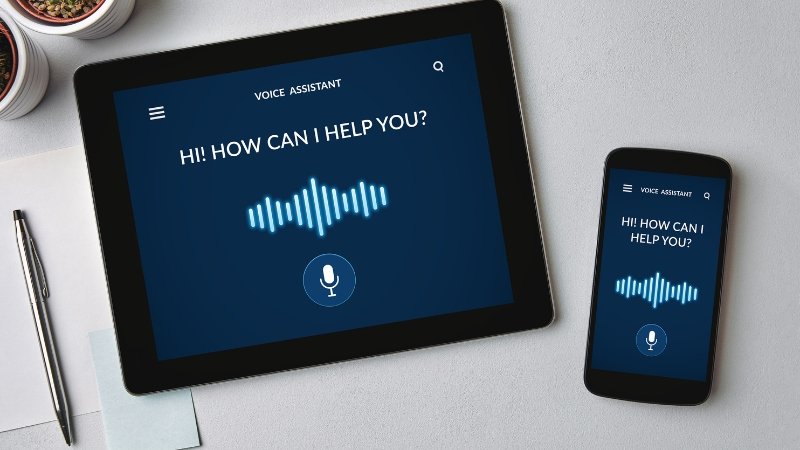The digital world is changing fast as people use conversational tech more. Voice searches have become key for talking to devices. Businesses must choose to adapt to this new way or risk being missed by today’s shoppers.
Today, there are over 1 billion voice searches every month. This shows how fast people are using voice commands to find local stuff. It’s clear that voice searches are a big deal for finding what we need.
Experts say voice searches will be the norm by 2025. Companies that get good at handling voice requests will have an edge. Those who don’t might find it hard to reach customers who prefer talking to typing.
Key Takeaways
1. Understanding Voice Search Behavior and Local Consumer Intent

Voice search behavior is different from typing on a keyboard. People talk to their devices in a way that’s unique. This means local businesses have new chances to connect with customers.
Now, people expect quick answers that fit their voice and location. This change is big for how we use search technology.
How Voice Search Differs from Traditional Text Searches
Voice searches are like talking to a friend. They use full sentences and questions. For example, “Where can I get pizza delivered near me right now?” is different from “pizza delivery Chicago.”
These searches are longer and more detailed. They often include what you want and where you are. This helps businesses understand what you need.
Local Voice Search Query Patterns and Trends
Most voice searches are about finding things nearby. People ask for places to eat, directions, and hours of operation. “Near me” searches are very common.
More and more, people use voice search for urgent needs. This shows they’re ready to buy.
Consumer Voice Search Habits in 2025
By 2025, using voice search will be even more common. People will use it while driving or cooking. They expect fast, accurate answers.
Users want businesses with the latest info and good reviews. They look for quick answers about what you offer and where you are.
Search Type
Query Length
Local Intent
Conversation Style
Traditional Text
2-3 words
20% local
Keyword-based
Voice Search
7-10 words
60% local
Natural language
Mobile Voice
8-12 words
75% local
Question format
2. Optimize for Conversational and Question-Based Keywords

Understanding how people speak is key to voice search success. Unlike text searches, voice queries mimic everyday talk. Businesses must adjust their Local SEO to fit spoken language.
Voice search users often ask full questions. For example, “Where’s the best pizza place near me?” instead of “pizza restaurant.” This change affects keyword research and content creation.
“Voice search is not just about technology; it’s about understanding human conversation patterns and adapting our content to match how people naturally communicate.”
Identifying Long-Tail Voice Search Keywords
Long-tail voice search keywords are longer, with three to seven words or more. They reflect natural speech and specific needs. Tools like AnswerThePublic and Google’s “People Also Ask” section show common questions.
Focus on keywords starting with “who,” “what,” “where,” “when,” “why,” and “how.” Local businesses should use location-specific long-tail phrases. For example, “What time does the hardware store close today?” or “Who offers emergency plumbing services nearby?”
Incorporating Natural Language Patterns
Optimizing for natural language means writing like we speak. Use casual phrases and complete sentences that answer questions. Replace formal language with a conversational tone.
Change traditional keywords to voice-friendly ones. Say “What dental services are available in my area?” instead of “dental services.” This makes Local SEO better for voice search algorithms.
Think about regional dialects and local expressions for voice search keywords. Different areas use different terms for the same things.
3. Master Your Google My Business Profile for Voice Search
Your Google My Business profile is key for voice assistants to answer local questions. When people ask Siri, Alexa, or Google Assistant about nearby businesses, they get info from your GMB listing. So, making your profile the best is vital for Voice Search SEO.
Voice assistants prefer businesses with full, correct profiles for spoken results. If your info is missing or wrong, you’re less likely to be suggested to customers. A top-notch profile can make you 70% more visible in voice search.
Complete Business Information Optimization
Having the same business name, address, and phone number (NAP) everywhere is crucial for voice search. Voice assistants check this info to make sure it’s right. If it’s not the same everywhere, your local search rankings could drop.
Your business description should use the same language people use in voice searches. Write in a way that answers common questions. Include your main services, where you are, and what makes you special.
Choosing the right categories is key for voice search visibility. Pick the most specific primary category that fits your business. Add secondary categories for broader voice queries related to your services.
GMB Element
Voice Search Impact
Optimization Priority
Update Frequency
Business Name
High
Critical
Only when changed
Address & Phone
High
Critical
When relocated
Business Hours
Medium
Important
Weekly review
Business Description
Medium
Important
Monthly updates
Regular Content Updates and Posts
Posting fresh content shows search algorithms your business is alive and relevant. Regular GMB posts help you show up in voice search results. Post weekly about services, events, or special deals.
Voice assistants like businesses that keep in touch with customers. Share photos, announce new services, and highlight customer feedback through GMB posts. This boosts your local search authority.
Managing Customer Reviews for Voice Search Impact
Good reviews help voice search recommend your business. Voice assistants often share review ratings when suggesting businesses. Keep your average rating above 4.0 stars for the best voice search results.
“Reviews are the new word of mouth, and voice search amplifies their importance in local business discovery.”
Always respond to reviews quickly and nicely. Your responses show up in search results and show your customer service quality. Use everyday language in your responses, just like in voice queries.
4. Implement Advanced Schema Markup for Local Businesses
View this post on Instagram
Structured data markup is key for voice search optimization. It helps search engines understand what your business is about. This makes it easier for voice assistants to share your business info with users.
Schema markup turns website data into something computers can read. Voice search algorithms use this info to give users the right answers to their questions.
LocalBusiness Schema Implementation
LocalBusiness schema gives voice assistants the details they need. This includes your business name, address, phone number, and more. It also covers your hours and what services you offer.
To use the LocalBusiness schema, you need to add JSON-LD code to your website’s header. Or, you can use plugins for structured data. Make sure to include your location, business type, and payment options. Local SEO experts can help with this.
FAQ Schema for Voice Query Optimization
FAQ schema is all about answering common questions. Voice assistants often use this content when users ask specific questions.
To set up FAQ schema, you need to format your questions and answers with special tags. Each FAQ should answer real questions in a way that sounds natural.
Review and Rating Schema Setup
Review schema helps show your business’s credibility in voice search. It displays star ratings and customer feedback. This can make your business more appealing to voice assistants.
To use the review schema, mark up each review and your overall rating. Include the reviewer’s name, rating, and when they left the review. This boosts your visibility and trustworthiness in voice searches.
5. Create Voice Search SEO Content That Ranks

Today’s voice search algorithms look for content that sounds like real human talk. They want answers that are quick and to the point. Businesses need to change how they write to meet these new needs.
Voice search content is very different from regular SEO writing. People speak in full sentences and ask questions directly. They want answers that sound natural when a voice assistant reads them out.
Writing Content for Voice Search Algorithms
Voice search algorithms like content that sounds like a conversation. Writers should use everyday language and short sentences. This helps search engines understand the content better.
Try to answer questions directly and simply. Start paragraphs with clear answers before adding more details. Use active voice and the present tense to make your content more engaging.
Structuring Content for Featured Snippets
Featured snippets are key for voice search answers. Use clear headings, numbered lists, and bullet points. This makes it easy for search engines to present answers.
Make content blocks that answer questions in 40-60 words. Use formats like definitions, step-by-step guides, and comparison tables. These formats work well for voice assistants to share information.
Local Content That Answers Common Voice Queries
Local voice searches often ask about business hours and directions. Create content that answers these questions using natural speech patterns.
Make FAQ sections for questions like “What time does [business] open?” or “Where can I find [service] near me?” Include local landmarks and events in your content. This helps capture local voice searches.
6. Dominate “Near Me” Voice Search Results
@webhivedigital Not enough businesses are optimising for voice search and it’s a huge missed opportunity!🤯 Voice searches (think Alexa & Siri) often show just 1-3 results, so getting your business on here can drive a lot of new traffic! Here are a few SEO tips to help you optimise your website and be more likely to come up on voice search! #Businesstok #voicesearch #searchengineoptimisation #SEO #voiceseo #marketing #digitalmarketing ♬ original sound – Kate Smoothy | SEO Specialist
Location-based voice queries have changed how we find local businesses. Now, voice searches are three times more likely to be about nearby places. This makes it key for businesses to focus on “near me” searches to stay ahead.
Understanding Location-Based Voice Query Intent
People using voice search for local services have clear needs. They might say “find a coffee shop near me” or “where’s the closest pharmacy.” These searches show they want to buy something right away.
Local SEO needs to understand why people search for local things. They want quick, relevant answers that match their location and needs. Since they’re often using mobile devices, they need easy access to business info and directions.
Optimizing for Proximity and Relevance Factors
Voice search algorithms look at several things when ranking local businesses. How close you are and how relevant you are are both important.
Proximity Factor
Relevance Factor
Optimization Strategy
Physical Distance
Business Category Match
Accurate GMB categorization
Service Area Coverage
Review Quality
Active review management
Location Consistency
Content Relevance
Location-specific content creation
Neighborhood Presence
Search History
Community engagement activities
Businesses should use local keywords and names in their content. Success in local SEO means having the same NAP info everywhere. Keeping up with local events and services helps voice search algorithms see you as relevant.
7. Prioritize Mobile-First Optimization for Voice Users

Voice search users often use mobile devices. This makes mobile-first optimization key for SEO success. Mobile users are three times more likely to use voice search than desktop users.
Local businesses need to know that voice search queries mainly happen on smartphones and tablets. Users want quick answers to their questions. Slow mobile performance hurts voice search visibility and user happiness.
Page Speed Optimization for Voice Search
Page speed is crucial for Voice Search SEO on mobile. Voice search algorithms favor fast-loading sites. Slow sites rarely show up in voice search results.
Google PageSpeed Insights can spot mobile performance problems. Compress images to make them smaller without losing quality. Also, minify CSS and JavaScript code to speed up loading.
Enable browser caching to store files locally. This makes sites load faster. Use Accelerated Mobile Pages (AMP) for super-fast loading. AMP pages load almost instantly, giving businesses an edge in voice search results.
Mobile User Experience Enhancement
Responsive design makes websites work well on all screen sizes. Touch-friendly interfaces help users navigate easily. Large buttons and clear text make it easier to use.
Streamlined navigation helps users find what they need fast. Remove things that slow down mobile sites. Focus on content that answers voice search questions directly.
Voice Search Functionality on Mobile Devices
Add voice search bars to mobile websites. This lets users keep searching on your site. Voice-activated features improve user experience and engagement.
Test voice search on different mobile systems. Make sure it works with iOS Safari, Android Chrome, and other browsers. Regular testing keeps technical issues away from voice search performance.
8. Build Comprehensive FAQ Pages for Voice Queries
Voice search optimization needs well-thought-out FAQ pages. These pages connect user questions with voice assistant answers. People often ask full questions when using voice search, unlike typing short keywords.
FAQ pages are key for voice assistants to find quick, correct answers. Smart businesses make FAQ content that meets user needs right away.
Identifying Common Voice Search Questions
Creating effective FAQs starts with knowing what customers ask. Business owners should look at customer service chats to find common questions. These chats show how people naturally speak.
Google’s “People Also Ask” sections offer insights into related questions. Tools for keyword research uncover long-tail phrases people speak. Social media and reviews often have questions that reflect voice search habits.
Industry forums and discussions highlight specific issues that lead to voice queries. Checking out competitors’ FAQs can show what questions are missing.
Structuring FAQ Content for Voice Results
Voice assistants like answers that are short and to the point. Each FAQ answer should start with the most critical info first. This way, voice search users get answers fast.
Use natural, conversational language in questions. Organize FAQs by topic for better flow and understanding. Adding FAQ schema markup helps search engines show questions and answers well.
Keep FAQ content up-to-date to match voice search trends. This ensures users always get the latest information.
9. Strengthen Local Citations and Directory Presence

Building a strong local citation network is key to voice search success. Voice assistants need consistent business info online to give good answers. When your business info is the same everywhere, search engines trust you more.
Having a solid citation profile shows you’re a trusted local business. This makes voice search algorithms think of you first when users ask for local info.
Maintaining Consistent NAP Information
Keeping your NAP info the same everywhere is crucial for Local SEO. Voice search checks different sources to make sure your info is right.
First, do a detailed citation audit to find any mistakes. Use tools like Moz Local or BrightLocal to check for wrong business details. Even small differences can mess up voice search.
Make a master NAP document that’s your go-to for business info. It should have your business name, address, and phone number exactly as they are. Share this with everyone who updates your online listings.
Industry-Specific Directory Optimization
General directories like Google Business Profile are important, but industry-specific ones are even more so. These platforms have more authority in your field.
Look for directories that fit your industry and location. For restaurants, Yelp and OpenTable are key. Professional services should focus on industry associations and local chambers.
Fill out each directory with the right business info, a good description, and the right categories. Keep an eye on them to make sure your info stays up to date.
10. Leverage Customer Reviews for Voice Search Authority

Customer reviews are key for voice assistants to find local businesses. They look at what people say, how much they like it, and how they respond. Good reviews help you show up more in voice search results.
When you ask “find the best restaurant near me,” voice assistants check reviews. They look at both how many reviews you have and what people say in them.
Review Generation and Management Strategies
Getting good reviews means timing is everything. Ask for them right after a customer is happy. Make it easy by giving them a link to leave a review.
Follow the rules for asking for reviews to avoid trouble. Send a personal message to explain why reviews matter. You can offer a small thank you, but never pay for good reviews.
Review Platform
Voice Search Impact
Optimization Priority
Key Features
Google My Business
High
Critical
Direct integration with Google Assistant
Yelp
Medium
Important
Detailed review content analysis
Facebook
Medium
Moderate
Social signals and recommendations
Industry-Specific
Low-Medium
Supplementary
Niche authority building
Responding to Reviews for SEO Benefits
Answering reviews adds more content for Voice Search SEO. Be professional and use the right keywords. Say thank you for good reviews and fix problems in bad ones.
“Businesses that respond to reviews see a 12% increase in customer trust and improved search rankings across all platforms.”
Ask for detailed reviews that mention your location and use keywords. This helps voice assistants match your business with what users are looking for.
11. Master Technical SEO Elements for Voice Search

Mastering technical SEO elements is key to being seen in voice searches. It helps search engines understand and share your content. This makes your site ready for voice assistants to quickly find and use your info.
A detailed technical SEO audit checklist points out what needs work for voice search. These technical parts affect how search engines see and rank your content for voice queries.
Site Architecture and Voice Search Crawling
A clean site architecture makes it easy for search engines to get your content. Voice search algorithms use this to figure out if your content is relevant and trustworthy.
Important architectural parts include:
Security and HTTPS Implementation
HTTPS encryption is crucial for voice search rankings. Voice assistants prefer secure sites when giving recommendations.
Security boosts voice search performance by showing trust to search algorithms. Sites without SSL certificates rank lower in voice search results.
Core Web Vitals Optimization
Core Web Vitals affect voice search rankings through user experience signals. These metrics check loading speed, interactivity, and visual stability.
Key optimization strategies are:
Keeping an eye on these technical elements helps maintain voice search performance and rankings.
12. Develop a Voice-Optimized Content Strategy

Voice search content strategy focuses on making content that answers questions like we do in everyday talk. Businesses need to change how they make content. They should move from keyword-focused writing to natural speech that voice assistants can easily share with users.
Knowing what is voice marketing helps businesses make content that works well on all voice platforms. The main thing is to plan content that answers questions and talks like a conversation.
“Content that sounds natural when read aloud by voice assistants while maintaining SEO effectiveness is the gold standard for voice search optimization.”
Creating Conversational and Natural Content
Conversational content is like how we speak, not how we type. It uses contractions, asks direct questions, and gives clear answers. Voice search users want quick, useful answers.
Content should sound natural when read out loud. Check this by having team members read it out loud. Look for awkward phrasing or unnatural word choices. Make guides, step-by-step instructions, and FAQs that answer common voice search questions.
Local Event and Community Content
Content focused on the community boosts Local SEO in voice search. Talk about local events, news, and topics people often ask about. This includes local business spotlights, event coverage, and pages about local resources.
Create content about local landmarks, seasonal events, and community interests. Voice search users often ask about nearby activities, services, and events. Businesses that provide this info build trust and authority with search engines and locals.
Make ongoing content themes to keep your voice search authority strong. Regularly covering local topics makes your business a go-to for community info.
13. Track and Measure Voice Search Performance

Measuring voice search performance is different from traditional SEO analytics. It needs special tracking methods that standard tools often miss. Businesses must have detailed strategies to see how well they do in voice search and improve.
Traditional ranking tools might not show voice search results correctly. Voice queries can lead to different results than text searches. This makes it hard for businesses to measure their voice search efforts.
Voice Search Ranking Monitoring Tools
There are special tools for tracking voice search performance. Google Search Console gives insights into voice search traffic. The Performance report shows which queries lead to voice results and featured snippets.
SEMrush and Ahrefs also track voice search. They monitor featured snippet positions and local pack appearances. They track question-based keywords that often lead to voice responses.
BrightLocal focuses on local voice search. It tracks “near me” queries and local business visibility. It provides detailed reports on local search performance across different voice assistants.
Analytics and Traffic Measurement
Google Analytics needs special setup to track voice search traffic. Custom segments help separate voice-driven sessions from regular organic traffic. Mobile traffic analysis shows voice search patterns since most queries happen on mobile.
Conversion tracking is key for Voice Search SEO measurement. Voice search users often have high purchase intent. Setting up goal tracking helps measure the business impact of voice search optimization.
Key Performance Indicators for Voice SEO
Voice search success depends on specific KPIs beyond traditional rankings. Featured snippet captures show voice search visibility. Local pack appearances show local voice search performance.
KPI Category
Metric
Measurement Method
Target Goal
Visibility
Featured Snippet Captures
Search Console Position Tracking
Top 3 Results
Local Performance
Local Pack Appearances
Local Ranking Tools
Top 3 Local Results
Traffic Quality
Voice Search Conversion Rate
Analytics Goal Tracking
Above Industry Average
Content Performance
Question-Based Query Rankings
Keyword Tracking Tools
Page 1 Rankings
Mobile traffic patterns show voice search usage trends. Page load speed metrics also impact voice search performance. Regular monitoring helps find optimization chances and measure progress over time.
14. Future-Proof Your Local Voice Search Strategy

Voice search technology is getting better and spreading to new places. By 2025, over 8 billion voice assistants will be used worldwide. This means businesses need to get ready for a future where voice is how people find local services.
The world is changing fast. Smart home systems, car assistants, and wearables are new ways to connect with customers. Each one has its own challenges and chances for local businesses.
Emerging Voice Search Technologies and Platforms
IoT devices are changing how we find local info. Smart fridges help find grocery stores. Wearables suggest gyms and health services. Cars give tips on restaurants and gas stations on the way.
Augmented reality is combining voice with visual search. You can point your phone at a store and ask for info. This mix of voice and visual data is new.
Voice commerce is becoming big. People are using voice to buy things and book services. Businesses need to make sure their systems work with voice assistants.
AI and Machine Learning in Voice Search Evolution
AI is making voice search smarter and more personal. Machine learning gets to know what users like and where they are. This helps local businesses show up in better search results.
Voice assistants are getting better at understanding complex questions. Local businesses should write content that answers these detailed questions.
To stay ahead, keep an eye on updates and try new platforms. Successful businesses are flexible and can change with voice search advancements.
Conclusion
Voice search optimization is changing how businesses market online. Companies that get on board will lead those stuck in old ways.
This guide offers a detailed plan for local SEO success. It’s all about optimizing Google My Business, using conversational keywords, and focusing on mobile users. These steps help catch voice search traffic.
Being technically sound is key for voice search success. Websites need to load fast, use schema markup, and have structured data. Local citations and consistent NAP info also boost visibility.
Voice search tech is getting smarter fast. AI and machine learning are improving every year. Early adopters will have a big advantage.
Success means keeping an eye on how well things are working and making changes as needed. Voice search trends shift with consumer habits. Keeping content fresh, managing reviews, and updating tech are essential for lasting success.
The digital world favors quick adaptors. Voice search optimization is now a must for businesses wanting to succeed. Being flexible and keeping up with new voice search tech is crucial for lasting success.

